Many thanks to SWLing Post contributor, Grayhat, who writes:
Hi Thomas, was about to write you about some infos related to the NooElec balun when found that they now offer a v2 model:
https://www.nooelec.com/store/balun-one-nine-v2-barebones.html
The new balun has the same schematic as the previous one:
But it is slightly bigger, has a better connector for the antenna wires and (according to NooElec) uses a transformer which allows the tiny balun to work more efficiently from 0 to around 70 MHz (check out the charts found in the downloads section of this link).
The transformer used, judging from the pics, is a CoilCraft WB9-1, whose data can be found here:
https://www.coilcraft.com/wb_th.cfm
As I wrote the reason for this was the fact that a friend of mine reported that he used the (v1) balun with a Loop On Ground (LoG) Antenna !
If you look at the schematic (above) you’ll notice that there’s a “jumper” labeled R1 (zero Ohm resistor). That tiny detail is important, see, leaving the balun as is, it will work fine with a longwire, one just connects contact #1 to the antenna and #2 to a counterpoise or ground system and there he goes, BUT there’s another way to use the balun, that is, CUT the “jumper” (ok, resistor) labeled “R1”. If you cut it, the balun will become a 9:1 isolation transformer and with such a modification will work just fine with the KK5JY “LoG”
antenna: http://www.kk5jy.net/LoG/According to what my friend reported, the balun works just fine, and although probably the ferrite core used in the V1 isn’t up to par with the original one used by KK5JY, the difference isn’t so huge.
Oh, and I also suspect that the modified balun may work fine with the KK5JY simpler passive loop http://www.kk5jy.net/rx-loop/ which may be a nice antenna for restricted spaces!
I think it may be of interest to people not knowing/willing to wind their own baluns, at that point one may just need an enclosure to protect the balun and putting up a receive antenna will be as easy as 1-2-3.
Thank you for sharing this! Readers: Grayhat has been encouraging me to deploy a LoG antenna at my home and I do plan to do so in the coming months. Please comment if you use a LoG similar to the KK5JY model and what your results have been.
Thank you again for the tip, Grayhat!








